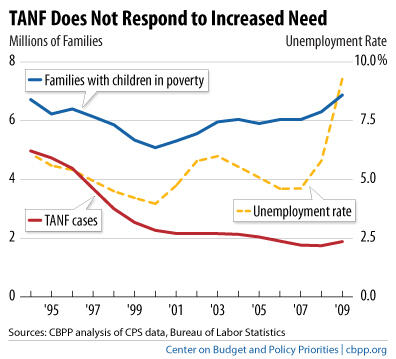BEYOND THE NUMBERS
House Budget Committee Chairman Paul Ryan cites the “unprecedented success” of welfare reform to support his claim that the House-passed Republican budget that he authored would “strengthen the safety net.” The facts tell a very different story.
Describing the elements of his budget plan that relate to the safety net, Ryan wrote recently in the Christian Science Monitor, “we are building upon the success of the welfare-reform law, which transformed that program into a block grant and gave states more control over its implementation.” Indeed, the Ryan plan would convert Medicaid and SNAP (formerly called food stamps) into block grants.
So, how did welfare reform do?
In its early years, welfare reform, which replaced Aid to Families with Dependent Children (AFDC) with Temporary Assistance for Needy Families (TANF), benefited from an especially strong labor market. In its first five years, unemployment never rose above 5.4 percent (in November and December 1996) and reached a low of 3.8 percent in April 2000. But, the employment and earnings gains were short-lived. As critics warned when Congress debated welfare reform in 1996, shifting to a block grant with fixed federal funding has resulted in a greatly weakened safety net that failed to respond effectively when the economy weakened and need rose.
- The employment gains of the early years of welfare reform, when the labor market was unusually strong,have since been wiped out. The share of poorly educated single mothers with earnings rose from 49 percent in 1995 to 64 percent in 2000 but has since fallen or remained constant every year. By 2009, it had fallen to 54 percent — the same level as in 1997, the first full year of TANF implementation.
- Welfare reform made the poorest families poorer. As my colleague Arloc Sherman noted yesterday, recent research shows that welfare reform is the primary reason why the share of families in deep poverty — with incomes below 50 percent of the poverty line, now just $9,265 for a family of three — rose by nearly half between 1984 and 2004.
- Welfare reform has left a large and rising number of families with children disconnected from both work and the safety net.A recent Urban Institute report found that about one in five low-income single mothers neither worked nor received government cash assistance in the 2004-2008 period, up from one in eight during 1996-1997.
- TANF has failed to respond adequately to increased need during the current downturn.As Chairman Ryan notes, the TANF caseload fell dramatically immediately after Congress enacted welfare reform. But it continued to decline even when the economy weakened and need rose (see chart). By 2009, there were just 28 families on TANF for every 100 families in poverty. In 1995, there were 75 families on AFDC for every 100 families in poverty.Moreover, the national TANF caseload rose by just 13 percent during the current downturn, even though the number of unemployed doubled. In 22 states, caseloads showed little or no increase.
Image
- With federal funding fixed and many TANF funds going to other purposes, states are scaling back their TANF programs despite unprecedented need. Using the flexibility that federal TANF rules afforded them, states shifted federal and state TANF funds from cash assistance and related services for poor families to various other programs (such as child care, child welfare, homeless assistance, and teen pregnancy prevention), enabling them to scale back state funding for those programs. In fiscal year 2007, states used just 30 percent of their federal and state TANF funds on basic assistance to families with children.When the economy slumped badly and TANF caseloads began rising, state TANF agencies were unable to reclaim the transferred funds to cover the costs of assisting the growing number of families in need. Many are responding by cutting already-low TANF benefits further, tightening time-limit policies, or eliminating services for low-income working families.
